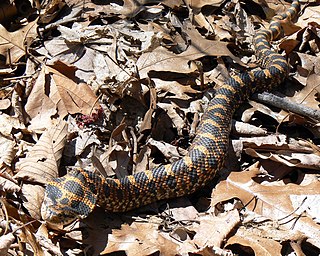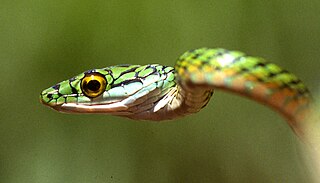
Coral snakes are a large group of elapid snakes that can be divided into two distinct groups, the Old World coral snakes and New World coral snakes. There are 16 species of Old World coral snakes, in three genera, and over 65 recognized species of New World coral snakes, in two genera. Genetic studies have found that the most basal lineages have origins in Asia, suggesting that the group originated in the Old World. While new world species of both genera are venomous, their bites are seldom lethal; only two confirmed fatalities have been documented in the past 100 years from the genus Micrurus. Meanwhile, snakes of the genus Micruroides have never caused a medically significant bite.

Micrurus is a genus of venomous coral snakes of the family Elapidae.

Boiga is a large genus of rear-fanged, mildly venomous snakes, known commonly as cat-eyed snakes or simply cat snakes, in the family Colubridae. Species of the genus Boiga are native to southeast Asia, India, and Australia, but due to their extremely hardy nature and adaptability, have spread to many other suitable habitats around the world. There are 38 recognized species in the genus. According to the study done by Jiří Smíd regarding Old World cat snakes, the ancestor of the cat snake originated in Africa, from where it diversified and expanded to other countries. Despite this diversity however, the different species have very similar needs in terms of temperature and precipitation.

Hognose snake is a common name for several unrelated species of snake with upturned snouts, classified in 2 colubrid snake families and 1 pseudoxyrhophiid snake family.
Philodryas is a genus of colubrid snakes endemic to South America, commonly called green snakes.
Lystrophis is the genus of tricolored South American hognose snakes. They mimic milk snakes or coral snakes with their red, black, and white ringed patterns.

Masticophis is a genus of colubrid snakes, commonly referred to as whip snakes or coachwhips, which are endemic to the Americas. They are characterized by having a long, thin body and are not dangerous to humans.

The Natricinae are a subfamily of colubroid snakes, sometimes referred to as a family (Natricidae). The subfamily comprises 36 genera. Members include many very common snake species, such as the European grass snakes, and the North American water snakes and garter snakes. Some Old World members of the subfamily are known as keelbacks, because their dorsal scales exhibit strong keeling.

Lycodon is a genus of colubrid snakes, commonly known as wolf snakes. The Neo-Latin name Lycodon is derived from the Greek words λύκος (lykos) meaning wolf and οδόν (odon) meaning tooth, and refers to the fang-like anterior maxillary and mandibular teeth. They are nonvenomous, but many members of this genus strongly resemble the venomous kraits in appearance, an example of Emsleyan mimicry.

Calamaria is a large genus of dwarf burrowing snakes of the family Colubridae. The genus contains 66 recognized species. The genus is endemic to Asia.

Dendrophidion is a genus of New World colubrid snakes commonly referred to as forest racers.

Stenophis is a genus of Madagascan arboreal snakes, part of the family Lamprophiidae. Species of Stenophis typically have large heads relative to their body size, and their bodies are elongated and often thin. The genus includes both viviparous and oviparous species. They usually have prolate pupils.

Geophis is a genus of snakes in the subfamily Dipsadinae of the family Colubridae of the superfamily Colubroidea. Species in the genus Geophis are commonly referred to as Latin American earth snakes. The genus consists of 53 distinct species.

Leptophis is a genus of colubrid snakes, commonly known as parrot snakes. The species within this genus are widely distributed throughout Mexico, Central and South America.

Oxyrhopus, the false coral snakes, is a genus of colubrid snakes that belong to the subfamily Dipsadinae. The genus is found in Central America and the northern part of South America, and it includes 15 distinct species.
Thamnosophis is a genus of pseudoxyrhophiid snakes found only on the island of Madagascar. As of 2014, six species were recognized.

Dipsadinae is a large subfamily of colubroid snakes, sometimes referred to as a family (Dipsadidae). They are found in most of the Americas, including the West Indies, and are most diverse in South America. There are more than 700 species.

Pseudoboa, the false boas, is a genus of snakes in the family Colubridae. The genus is endemic to South America.
Stegonotus is a genus of snakes in the family Colubridae. Species of the genus Stegonotus are native to Australia, Indonesia, and New Guinea.















